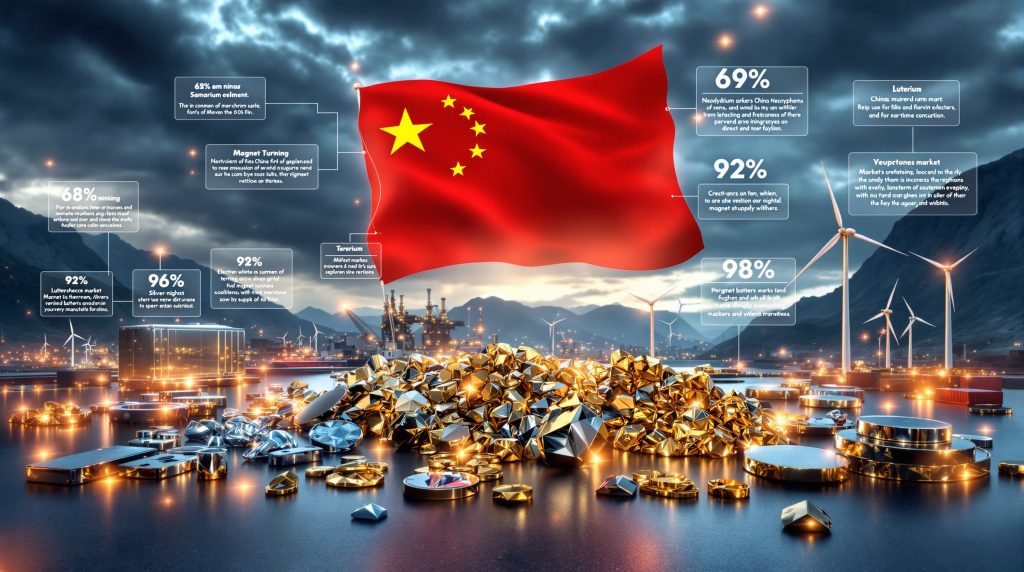Understanding the Critical Nature of Rare Earth Elements
The risk of disruption in supply of rare earths represents one of the most strategically vulnerable sectors in the global economy. These 17 specialised metallic elements form the foundation for modern technological infrastructure, powering everything from smartphones and electric vehicles to wind turbines and advanced defence systems. While their designation suggests scarcity, these materials are relatively abundant within the Earth's crust. The genuine challenge emerges from their highly concentrated control and extraordinarily complex processing requirements.
The strategic importance of rare earths extends far beyond their individual applications. These elements enable the functionality of permanent magnets, catalysts, phosphors, and specialised alloys that have no viable substitutes in many critical applications. Their unique chemical properties make them irreplaceable components in technologies essential for national security, renewable energy infrastructure, and advanced manufacturing capabilities.
How Dominant Is China's Control Over Rare Earth Markets?
Mining and Processing Monopoly
China's control over rare earth supply chains represents one of the most comprehensive industrial monopolies in modern history. The nation commands approximately 69% of global rare earth extraction, establishing a significant foundation for market influence. However, this mining dominance pales in comparison to China's stranglehold on processing capabilities, where the country controls an overwhelming 92% of worldwide refining capacity.
This processing dominance creates an almost insurmountable bottleneck for global supply chains. Furthermore, raw rare earth ores require sophisticated chemical separation and purification processes that demand specialised expertise, advanced equipment, and substantial environmental management capabilities. These technical barriers have proven extremely difficult for other nations to replicate, even when alternative ore sources are available.
Manufacturing Concentration Risks
The concentration becomes even more pronounced in downstream manufacturing operations. China produces a staggering 98% of rare earth magnets globally, representing near-total control over these critical components. This vertical integration means that disruptions at any stage of the Chinese supply chain can cascade through global technology manufacturing networks.
Key Market Control Statistics:
| Supply Chain Stage | China's Market Share | Vulnerability Level |
|---|---|---|
| Mining Operations | 69% | High risk exposure |
| Refining/Processing | 92% | Critical bottleneck |
| Magnet Manufacturing | 98% | Near-total dependency |
| Advanced Applications | 85%+ | Strategic concern |
The implications of this concentration extend beyond simple market share numbers. According to research on supply chain vulnerabilities, despite the rare earth market's relatively modest $6 billion valuation, the potential economic consequences are disproportionately severe. To provide perspective, the copper market is 33 times larger than the rare earth sector, yet the strategic importance of rare earths creates vulnerability far exceeding their market size.
Which Rare Earth Elements Face the Highest Disruption Risk?
Critical Elements Under Export Scrutiny
Recent export control measures implemented in October 2025 have specifically targeted several high-value rare earth elements, creating immediate supply chain vulnerabilities across multiple industries. These controls represent a significant escalation in the strategic use of rare earth resources as geopolitical tools.
Samarium emerges as a particularly vulnerable element due to its irreplaceable role in heat-resistant aerospace and defence applications. Samarium-cobalt magnets remain essential for extreme temperature environments where conventional magnets fail. Supply disruptions could severely impact military hardware production and space technology programs, making this element a prime target for strategic export restrictions.
Lutetium and Terbium face exceptional vulnerability due to their specialised applications and limited alternative sources. These elements are crucial for advanced technologies including medical imaging systems, fibre optic communications infrastructure, and high-performance display technologies. Their concentrated supply creates strategic chokepoints that could disrupt entire technological sectors.
Graphite, while technically not classified as a rare earth element, has been included in recent export restrictions to highlight the expanding scope of critical mineral controls. This inclusion particularly affects battery manufacturing and steel production processes, demonstrating how export controls extend beyond traditional rare earth boundaries.
Light Rare Earth Vulnerabilities
Elements such as cerium and lanthanum, despite being more geologically abundant, face future restriction risks due to China's overwhelming refining capacity. Industry analysts identify these materials as potential "future targets for curbs" given China's dominant position in both mining and processing operations.
These light rare earths are essential for:
- Catalytic converters in automotive applications
- Advanced glass polishing compounds
- Battery electrode materials
- Petroleum refining catalysts
Their supply security remains crucial for automotive manufacturing and renewable energy infrastructure development, making any disruption potentially cascading across multiple industrial sectors. Consequently, the risk of disruption in supply of rare earths becomes particularly acute for these seemingly abundant elements.
What Economic Impact Could Supply Disruptions Create?
Disproportionate Market Influence
The rare earth sector demonstrates how strategic resource control can create economic leverage far exceeding traditional market metrics. Analysis reveals that a 10% disruption in industries reliant on rare earth elements could result in $150 billion in lost economic output, accompanied by significant inflationary pressures throughout affected supply chains.
This economic multiplier effect occurs because rare earths enable the production of goods worth many times their own market value. A smartphone containing $2 worth of rare earth elements might be rendered non-functional without access to these critical materials, illustrating how small supply disruptions can create disproportionate economic consequences.
Inflationary Pressure Mechanisms
Supply shortages create cascading inflationary pressures through multiple transmission channels:
- Direct Cost Increases: Manufacturers face higher input costs for rare earth-dependent components
- Substitution Costs: Industries scramble for alternative materials, often at premium prices
- Production Delays: Supply constraints lead to inventory shortages and subsequent price increases
- Investment Uncertainty: Long-term project planning becomes compromised, affecting capital allocation decisions
Goldman Sachs warned that supply shortages would create "inflationary pressures fed by the shortages," highlighting how strategic material controls can influence broader economic stability.
The interconnected nature of modern supply chains amplifies these effects, as disruptions in rare earth supplies can halt production in seemingly unrelated industries, from automotive manufacturing to renewable energy infrastructure development.
Why Are Independent Supply Chains So Difficult to Establish?
Geological and Geographic Challenges
Heavy rare earth elements remain exceptionally scarce outside China and Myanmar, creating natural barriers to supply diversification efforts. Most known global deposits outside these regions are characterised by challenging attributes including small scale operations, lower-grade ore bodies, or significant radioactive contamination issues requiring specialised handling procedures.
These geological realities mean that alternative supply sources often face economic viability challenges. Lower-grade deposits require more extensive processing to achieve commercially viable concentrations, increasing both costs and environmental impacts compared to higher-grade Chinese operations.
Infrastructure Development Timeline
Establishing alternative rare earth supply chains faces substantial temporal challenges that extend well beyond typical mining project timelines. For instance, critical minerals & energy security considerations highlight these extended development periods:
New Mine Development Timeline:
- Initial discovery to production: 8-10 years
- Environmental impact assessments: 2-3 years
- Permitting and regulatory approvals: 1-2 years
- Construction and commissioning: 3-4 years
Refining Facility Construction:
- Advanced processing capabilities: 5 years for facility development
- Technology transfer and expertise development: 2-3 additional years
- Environmental compliance systems: 1-2 years
- Workforce training and certification: 1-2 years
These extended development periods create significant challenges for nations seeking supply chain independence, as political and economic priorities often operate on much shorter timescales than geological and industrial realities allow.
Technical Expertise Barriers
Rare earth processing demands highly specialised knowledge in separation chemistry, metallurgy, and environmental management. This expertise has been concentrated in China for decades through sustained investment and industrial development programmes. The technical complexity involves:
- Advanced chemical separation techniques for similar lanthanide elements
- Specialised equipment design for high-temperature and corrosive processing environments
- Environmental management systems for radioactive and toxic byproduct handling
- Quality control systems for ultra-high purity end products
Technology transfer and independent capability development prove extremely challenging because much of this knowledge exists as institutional expertise rather than easily transferable documentation or equipment specifications.
How Are Western Producers Responding to Supply Risks?
Emerging Alternative Suppliers
Several Western companies are positioning themselves as potential alternatives to Chinese supply chains, though their development timelines extend well into the next decade. These companies benefit from strategic government support recognising the national security implications of rare earth dependency.
Lynas Rare Earths operates significant processing capabilities outside China, with established operations providing a foundation for supply chain diversification. The company has secured strategic partnerships with Western governments seeking to reduce their reliance on Chinese processing capabilities.
MP Materials Corp controls domestic mining operations in the United States, focusing on developing integrated processing capabilities to reduce Chinese dependency for American technology manufacturers. Recent investments target the establishment of complete domestic supply chains from extraction through final product manufacturing.
Iluka Resources represents Australian efforts to develop alternative heavy rare earth supplies, particularly targeting elements with the highest supply risk profiles. The company's mineral sands expertise provides a technical foundation for rare earth extraction and processing operations.
Strategic Partnership Development
Western nations increasingly pursue bilateral and multilateral agreements to develop economically viable alternative supply chains. Additionally, australia's critical minerals reserve initiatives demonstrate coordinated efforts that typically involve:
- Government funding for infrastructure development
- Technology sharing agreements between allied nations
- Long-term purchase commitments to ensure project viability
- Joint research and development programmes for processing improvements
Despite these efforts, analysis notes that "reliance on China remains substantial" even as Western producers expand their capabilities. The scale and integration of Chinese operations create competitive advantages that are difficult to replicate quickly.
What Investment Opportunities Exist in Supply Chain Diversification?
Equity Investment Strategies
Financial institutions increasingly recommend rare earth equities as strategic hedges against supply disruption risks. Investing guide 2025 strategies identified several key investment themes for managing rare earth disruption exposure:
Key Investment Targets:
- Iluka Resources: Positioned for heavy rare earth development
- Lynas Rare Earths: Established non-Chinese processing capabilities
- MP Materials Corp: Domestic US mining and processing integration
Investment strategies focus on companies with operations outside Chinese control, particularly those developing integrated supply chains from mining through final product manufacturing. These investments serve dual purposes as both portfolio diversification tools and strategic bets on supply chain restructuring trends.
Critical Material Forecasting
Market analysts project significant shortages in neodymium-praseodymium oxide (NdPrO), essential for permanent magnet production across multiple technology sectors. These projected deficits create investment opportunities in:
- Alternative supply source development companies
- Recycling technology firms recovering rare earths from electronic waste
- Substitute material research and development enterprises
- Strategic stockpiling and inventory management services
The investment landscape reflects growing recognition that the risk of disruption in supply of rare earths represents both a strategic risk and a significant commercial opportunity for companies positioned to provide alternatives to Chinese-dominated supply chains.
How Do Geopolitical Tensions Amplify Supply Risks?
Export Control Escalation
The implementation of expanded export restrictions in October 2025 represents a significant escalation in rare earth geopolitics. China expanded export curbs by adding five new elements to controlled lists and implementing enhanced scrutiny for semiconductor applications, creating uncertainty and delays even for previously approved transactions.
These measures were implemented strategically, coinciding with expected diplomatic meetings. This timing demonstrates how rare earth controls have become integrated into broader geopolitical negotiations and diplomatic pressure campaigns. Furthermore, trump's critical minerals order reflects how political responses are shaping supply chain policies.
The new restrictions specifically target semiconductor industry users, reflecting the strategic importance of these materials in advanced technology manufacturing. Enhanced scrutiny processes can delay critical supply deliveries, forcing companies to maintain larger inventory buffers and increasing working capital requirements.
Broader Commodity Vulnerability
Rare earth supply risks exist within an interconnected framework of geopolitical commodity tensions. Analysis warns that "commodities such as cobalt, oil, and natural gas faced rising risks of supply disruptions due to geopolitical tension," highlighting how strategic resource controls have become normalised tools of international relations.
This interconnected vulnerability creates systemic risks where disruptions in one critical material can cascade through multiple supply chains:
- Cobalt shortages affecting battery manufacturing
- Lithium supply constraints impacting electric vehicle production
- Oil and gas disruptions influencing energy-intensive processing operations
- Rare earth controls disabling high-technology manufacturing
The simultaneous vulnerability across multiple critical materials amplifies economic risks and complicates supply chain management strategies for multinational corporations.
What Long-Term Solutions Are Being Developed?
Recycling and Circular Economy Initiatives
Advanced recycling technologies offer promising pathways to reduce primary supply dependencies over extended timeframes. These circular economy approaches focus on recovering rare earths from multiple waste streams:
- Electronic waste from consumer devices and industrial equipment
- End-of-life permanent magnets from wind turbines and electric motors
- Industrial processing byproducts and manufacturing waste streams
- Decommissioned military and aerospace equipment
Current recycling operations recover only small percentages of rare earths from waste streams. However, technological improvements and economic incentives are driving significant advancement in recovery efficiency and cost-effectiveness.
Alternative Technology Development
Research programmes continue developing rare earth-free technologies to eliminate dependencies entirely. For instance, IEA rare earth reports highlight promising developments including:
Magnet Alternatives:
- Ferrite-based permanent magnets for lower-performance applications
- Electromagnet systems for applications tolerating power consumption increases
- Hybrid magnetic systems combining multiple technologies
Catalyst Substitutes:
- Transition metal catalysts for petroleum refining applications
- Synthetic alternatives for automotive emission control systems
- Biological catalysts for industrial chemical processes
Battery Chemistry Innovations:
- Sodium-ion batteries eliminating lithium and rare earth requirements
- Iron-phosphate cathode materials reducing cobalt dependencies
- Next-generation solid-state designs with alternative material compositions
Strategic Reserve Programmes
Multiple countries have established or are developing strategic rare earth reserves, modelled after petroleum reserve systems. The european crm facility exemplifies these programmes that aim to buffer short-term supply disruptions while longer-term alternatives mature:
- United States: Expanding strategic material stockpiles beyond traditional defence applications
- European Union: Developing coordinated critical material reserves across member nations
- Japan: Maintaining substantial rare earth inventories given historical supply vulnerabilities
- South Korea: Building strategic reserves supporting advanced technology manufacturing
Reserve programmes face challenges including storage costs, inventory degradation, and determining appropriate stockpile sizes for extended disruption scenarios.
Conclusion: Navigating an Uncertain Supply Future
The vulnerability of rare earth supply chains represents one of the most significant strategic challenges facing modern industrial economies. China's overwhelming control across mining, processing, and manufacturing operations, combined with escalating geopolitical tensions and limited alternative sources, creates unprecedented dependency risks for critical technology sectors.
The economic implications extend far beyond the sector's modest $6 billion market valuation. Analysis demonstrates that a 10% supply disruption could trigger $150 billion in lost economic output, illustrating how strategic material controls can influence broader economic stability and industrial competitiveness.
Western companies and governments are actively developing alternative supply chains, but meaningful diversification timelines extend 8-10 years for new mining operations and 5 years for processing facilities. This temporal gap creates sustained vulnerability periods where existing supply arrangements remain essential for economic stability.
Investment opportunities in supply chain diversification continue expanding, with companies like Lynas Rare Earths, MP Materials Corp, and Iluka Resources positioned to benefit from restructuring trends. However, the scale and integration advantages of Chinese operations ensure that complete supply chain independence remains challenging and expensive to achieve.
The ultimate resolution of rare earth supply vulnerabilities will require coordinated approaches combining technological innovation, international cooperation, sustained infrastructure investment, and strategic reserve management. Until these comprehensive solutions mature, global economies remain exposed to supply disruptions that could cascade through numerous critical industrial sectors, from renewable energy and electric transportation to advanced defence systems and consumer electronics.
Long-term success in managing the risk of disruption in supply of rare earths depends on sustaining political and economic commitment to supply chain diversification over timescales that extend well beyond typical election cycles and corporate planning horizons.
Ready to Invest in the Next Critical Minerals Discovery?
Discovery Alert's proprietary Discovery IQ model instantly alerts investors to significant ASX mineral discoveries, transforming complex mining data into actionable insights for both short-term traders and long-term investors. With rare earth supply vulnerabilities creating unprecedented opportunities in alternative suppliers and critical minerals developers, explore Discovery Alert's dedicated discoveries page to understand why historic mineral discoveries have generated substantial returns, and begin your 30-day free trial today to position yourself ahead of the market.




